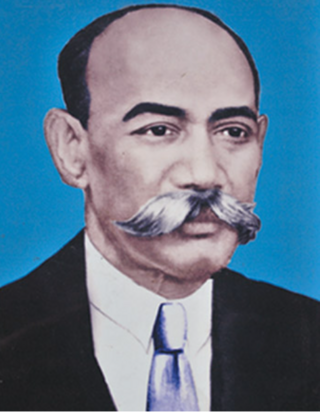Nalbari is a small town in Nalbari district in the Indian state of Assam. Nalbari is also the headquarters of Nalbari District.
Though the precise Etymology of Assam, a state in India is unclear—there is general agreement that it is related to the Ahom people. Whatever the source of the English name, Assam is itself an anglicization.

Pushyavarman was the first historical ruler of Kamarupa (Assam) in eastern India, who established the Varman dynasty in 350 AD.

Kalyanavarman ruled Kamarupa from the Varman dynasty for the period of 422–446 A.D. He was the son of Kamrupi king Balavarman and queen Ratnavati. He married Gandharvavati and had a successor to throne named Ganapativarman.

Ganapativarman ruled Kamarupa from the Varman dynasty for the period 446-470 A.D, was son of Kamrupi king Kalyanavarman and queen Gandharvavati. He married Yajnavati and had successor to throne named Mahendravarman.

Susthitavarman (590-595) was a ruler of Kamarupa. He was a son of Sthitavarman and Queen Nayanadevi.

Supratisthitavarman ruled Kamarupa from the Varman dynasty for the period 595–600. He was son of King Susthitavarman and Queen Shyamadevi.

Brahma Pala was the founder of the Pala Dynasty (990–1138) of the Kamarupa kingdom. He married Kula Devi, by whom he had a successor to his throne named Ratna Pala.

Indra Pala was ruler of Pala Dynasty (900–1100) of Kamarupa Kingdom.
Kamrupi literature is the literature written in the modern Kamrupi dialects of Assamese language.

Kamarupa was a kingdom in Northeast India that was ruled by three dynasties from their capitals in Pragjyotishpura, Haruppeshwara, and Durjaya. The kingdom was known for its power and influence in the region.

Kamarupa – Late to end period was a period of Kamarupa kingdom from founding of Pala Dynasty by Brahma Pala to last ruler of dynasty Jaya Pala.

Kamrupi dialects are a group of regional dialects of Assamese, spoken in the Kamrup region. It formerly enjoyed prestige status. It is one of two western dialect groups of the Assamese language, the other being Goalpariya. Kamrupi is heterogeneous with three subdialects— Barpetia dialect, Nalbariya dialect and Palasbaria dialect.

Kamrup is the modern region situated between two rivers, the Manas and the Barnadi in Western Assam, with the same territorial extent as the Colonial and post-Colonial "Undivided Kamrup district". It was the capital region of two of the three dynasties of Kamarupa and Guwahati, the current political center of Assam, is situated here. It is characterized by its cultural artifacts.
Bhusana Dvija was litterateur born in Dihga Nagara, Barnagar, Barpeta, Kamrup. He was specially known for his biographies named Guru Charita and Sankara Charita.

Kamarupi script was the script used in ancient Kamarupa from as early as 5th century to 13th century, from which the modern Assamese script eventually evolved. In the development of the Assamese script, this phase was followed by the medieval and then by the modern Assamese scripts.

Kamapitha is one of the four Kamarupa Pithas, the geographical divisions of ancient Kamarupa. Dineshchandra Sircar points out that these divisions are not found in the Kamarupa inscriptions and that they might be fabrications from late medieval sources, such as 16th-century work Yogini Tantra gives the boundaries of Kamapitha and other three pithas, the same work which gives boundaries of ancient Kamrup kingdom as well. The eastern border of Kamarupa was the temple of the goddess Tamreshvari near present-day Sadiya

Kanaklal Barua (1872–1940) was a prominent writer, essayist, historian and politician from Assam who wrote mainly in the English language. He was one of the literary stalwarts of the Jonaki Era, the age of romanticism of Assamese literature. He was the president of the Asam Sahitya Sabha in 1924 held at Dibrugarh district, Assam. In 1929 he was elected to Assam Legislative Assembly. He also served as a member of the Viceroy's Executive Council. He was the founder president of the Kamarupa Anusandhan Samiti. He was rewarded with the "Raibahadur" title by the British Government.
Padmanath Bhattacharya was an Indian historian. His works generally centred on the ancient Kamrup region. The Padmanath Vidyabinod Memorial Awards are named after him.







